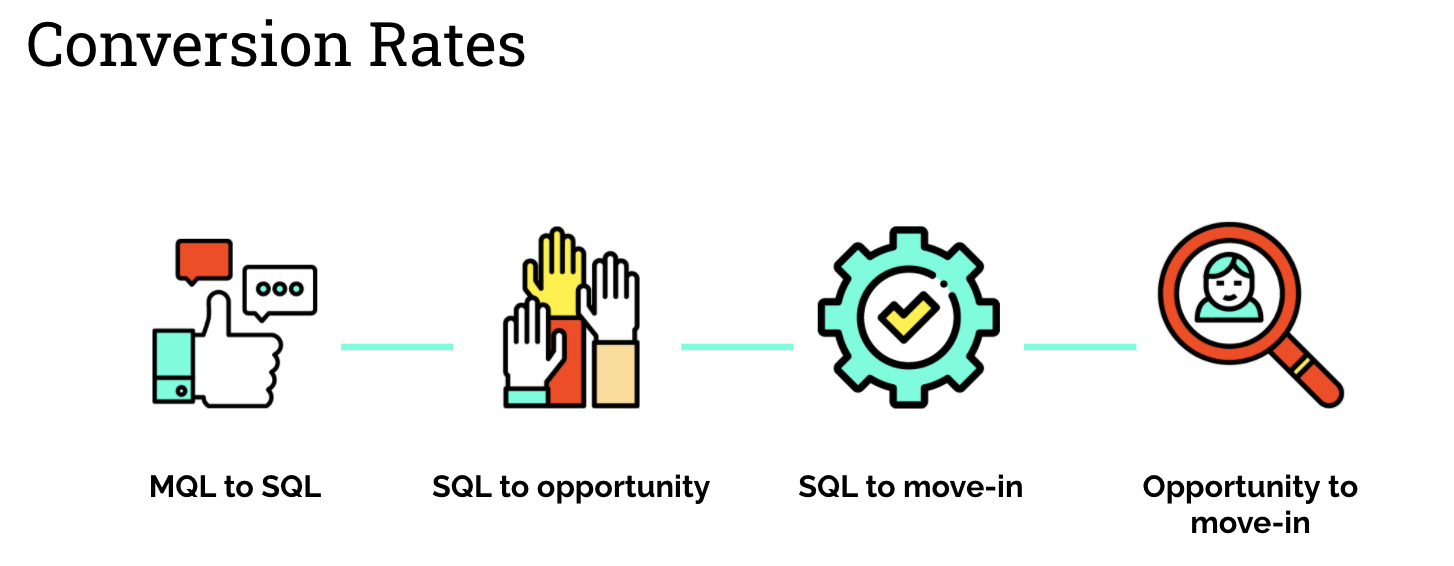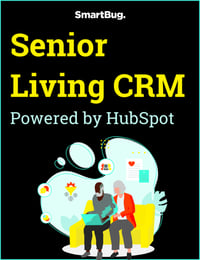
4 Strategies to Lower Your Senior Living Cost Per Move-In
November 2, 2020
During a tough year, many senior living organizations have had to reset revenue goals, cut back on marketing spend, and take other drastic measures.
In this kind of environment, every dollar counts, and that’s one reason why it is critical to understand your cost per move-ins. Although leads, SQLs, and opportunities are all part of the picture, senior living operators know that move-ins are always the end goal. And if move-ins are king, then cost per move-in is queen.
Is your cost per move-in too high? If so, how can you lower it? Here are a few ways to get started.
1. Understand your conversion rates.
A full-funnel or “closed-loop” understanding of marketing means tracking prospect activity from that first interaction as a lead all the way to a move-in. At each of these stages, you have the opportunity to evaluate how well prospects are converting from one stage to the next. For example:
- MQL to SQL
- SQL to opportunity
- SQL to move-in
- Opportunity to move-in

(Source)
Having a goal for a certain number of prospects at each stage is important, but your conversion rates will give you an even clearer idea of the quality of leads in your funnel.
NOTE: Having marketing and sales systems that “talk to each other” is critical to easily tracking prospects from A-Z through the funnel!
Conversion rates are an important part of the cost per move-in conversation, because you may be investing resources in producing a volume of leads that are not actually quality leads for your sales team. And that inflates your overall marketing costs—without producing the desired results.
2. Understand your cost per acquisition.
Cost per opportunity and cost per move-in are great equalizers across communities. Yes, volume of leads is important. And yes, conversion rates are important, too. But how much is each opportunity and move-in costing in marketing spend? That’s a question you—and your executives—will want to answer.
To determine your cost per opportunity, divide your marketing spend by the number of opportunities to see what your marketing efforts are costing. Same for cost per move-in. You can also add in your combined marketing and sales costs to calculate total cost per customer acquisition.
Take these metrics a step further by calculating these costs per channel so you can identify your most (and least) cost-effective channels. For example, you may discover that although paid media delivers a large volume of leads, those leads may be less qualified than your inbound leads. Or you may discover they are the same level of quality—but one lead source costs significantly more in marketing spend than the other. Or you may discover lower quality of leads from referral sources that cost more than your inbound leads.
Whatever the data shows, understanding cost per acquisition (by source) will help you allocate dollars to the channels that deliver the end results you need.
3. Benchmark your own metrics.
It would be great to have a magic target metric for cost per move-in, but it’s just not that simple. Every industry has its own criteria for success. And within senior living, every community, organization, and region has its own nuances.
What’s most important is to benchmark your own performance per community and then set measurable goals for incremental progress. The goal is not to improve by “x” percentage, but rather to see a steady improvement.
Another important nuance for senior living is to take into account both the size of the average entrance fee (if applicable) and the lifetime value of a new move-in. A cost per acquisition of $50 would likely be an unreasonable (and unnecessary) target for a move-in that will net a six-figure entrance fee plus monthly recurring revenue.
4. Don’t forget about retention.
According to the U.S. Small Business Administration and U.S. Chamber of Commerce, acquiring new customers can cost 5-7x more than retaining existing customers. Some turnover in senior living is unavoidable, but communities can focus on several key factors to improve overall resident satisfaction and retention, such as:
- Enriching programs for mind, body, and spirit
- Transparent communication with residents and families
- Virtual programs to keep residents connected
- Responsiveness to feedback and concerns
- Attentive and caring team members
You’ll be the best judge of how to lower your cost per move-in once you’ve seen the data. The strategies above can help you get to the root of any issues and unearth opportunities to lower those costs per move-in and boost your overall bottom line during a tough season.

HIPAA-Compliant Data Storage, Easy Occupancy Management, and More
Ready to Transform Your Senior Living Operations?

About the author
Ali Orlando Wert was formerly a Director of Marketing Strategy at SmartBug responsible for the strategy, execution, growth and goal achievement of her key accounts. She leads a cross-functional team of specialists in implementing strategic inbound marketing, digital marketing, marketing automation, paid media, sales enablement, conversion rate optimization, SEO, web development, social media and offline channels. Ali is a winner of CMA's Project of the Year and Best Content Marketing Program as well as a speaker at Content Marketing World and ContentTECH. Read more articles by Ali Orlando Wert.





